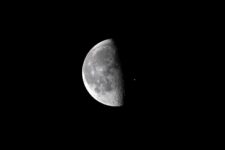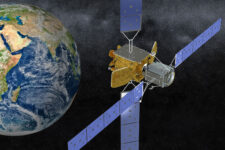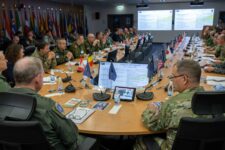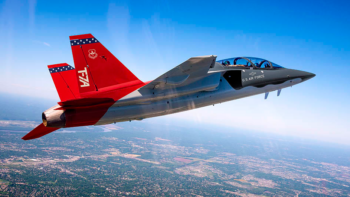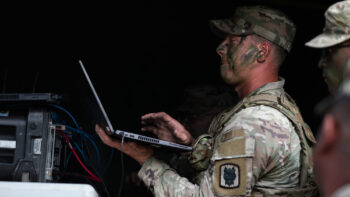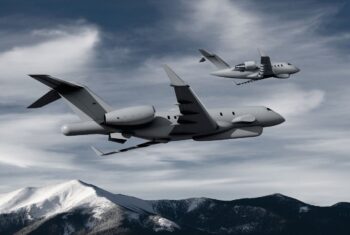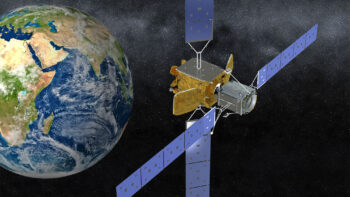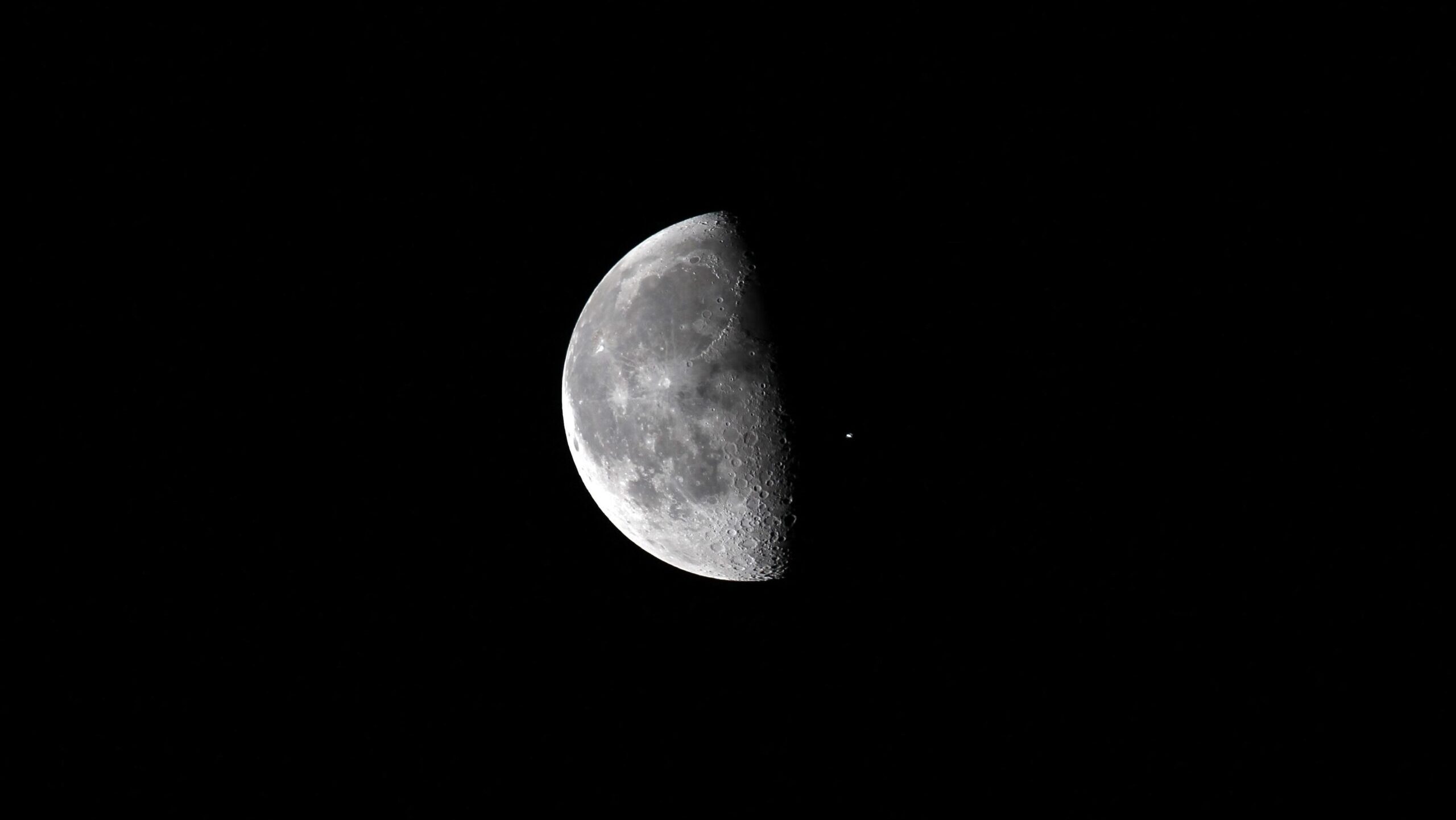
The International Space Station flew across the face of the moon on April 9, 2010. (Fernando Echeverria / NASA)
WASHINGTON — A new, in-depth study by the Center for Strategic and International Studies (CSIS) finds no near-term value for military operations in cislunar space with the possible exception of space surveillance — and a considerable amount of “hype” about both technological readiness and the commercial business case.
“Though there is certainly a lot of buzz about cislunar growth, the authors of this report found evidence of only a modest increase in cislunar activities over the next decade compared to the past 10 years,” the study states. “The authors also could not identify any compelling strategic military value from cislunar space and did not foresee one developing in the next decade that could make a decisive difference in any conflict between the United States and China, Russia, or another nation-state.”
“However, national security organizations may want access to cislunar SSA [space situational awareness] data for surveillance purposes,” it adds.
The study, “Salmon Swimming Upstream: Charting a Course in Cislunar Space” and authored by Clayton Swope, deputy director of CSIS’s Aerospace Security Project, and Louis Gleason, a former CSIS intern, was released on Monday. Swope formerly was an executive at Amazon’s Project Kuiper, and previously did stints in Congress and at the Central Intelligence Agency.
The Defense Department has put operations in cislunar space — roughly the area between the Earth and the Moon — on its to-do list for 2040 and beyond, although there is a vocal contingent within the Space Force and its supporters for speeding capabilities in the face of what they say are China’s aggressive plans for control of the region and the Moon itself.
A number of small, early DoD research projects already ongoing are designed to enable potential cislunar and lunar surface activities, including at the Defense Advanced Research Projects Agency and Air Force Research Laboratory (AFRL). AFRL’s efforts include the Oracle program to develop a cislunar satellite to keep tabs on potential threats, natural and manmade, in the region.
The CSIS study, however, details a number of serious obstacles to cislunar operations that may take decades to resolve, ranging from basic scientific unknowns to technological hurdles to unanswered international governance questions.
Time Moves Faster On The Moon (And Other Issues)
“The list of related operational challenges is long,” the study says.
For example, there “is little space situational awareness (SSA) in cislunar space.” While the region is vast and not so heavily populated as Earth orbits, that lack still means that spacecraft in the region at the moment are flying with one eye closed to potential collisions with natural hazards such as micrometeoroids and manmade objects including space junk.
Further, the Global Positioning System (GPS) “was not designed for this region, so without enhancements it cannot reliably provide cislunar navigation and timing services,” the study says.
Working out reliable positioning, timing and navigation capabilities in cislunar space and on the Moon is complicated, the study explains. For one, even time itself “behaves differently on the Moon due to the theory of relativity. The motion of the Moon relative to Earth, as well as its lower gravity, means that time actually moves 56 microseconds faster on the Moon than on Earth each day. While this difference may seem unimportant on the surface, precision time measured to nanoseconds is typically needed for navigation.”
Further, the study points out that there is a need for crafting a precise “lunar reference model” that not only provides topical maps of the lunar surface, but also maps of the magnetic and gravitational fields in the cislunar and lunar region — something that an interagency group including the National Geospatial-Intelligence Agency, NASA, the US Geological Survey, the US Space Force and US Space Command now are working to develop.
There are other problems posed by physics for systems operating in the vast region of space beyond the Earth’s orbit and on the lunar surface, CSIS notes.
“In classical orbital mechanics, the motion of a near-Earth satellite can be predicted as part of a two-body problem (i.e., Earth and the spacecraft). In cislunar space, this two-body problem poorly predicts motion,” the study says. Instead, operators have to calculate a three-body problem (i.e. Earth, the Moon and the spacecraft), which is mathematically tricky and requires the refinement of new operational models for how orbits work in the region.
“Other issues, such as the impacts of cosmic radiation and lunar dust on equipment and humans, also pose hazards to cislunar missions,” the study adds.
Governance Challenges
Like the situation for activities in Earth orbit, CSIS finds that international space governance frameworks for cislunar space “lack needed clarity and definition in three main areas: space rules of the road, property rights and resource use, and permissible activities.”
These gaps increase risks in a number of ways, the study elaborates.
“As international space activities increase, particularly by the United States and China, space will become less safe and secure if these deficits are not addressed. A lack of agreed-to and followed space rules of the road will increase spacecraft collision risks. A lack of consensus by spacefaring nations on property rights, space resources, and permissible activities will lead to a greater chance of misunderstandings and miscalculations by space powers, potentially increasing geopolitical tensions and sparking conflict on Earth,” the study says.
“These hazards are particularly acute for cislunar space,” the study warns.
A Lunar Economy? Not So Fast
One of the reasons supporters have given for a beefed-up military presence in cislunar space is the likely emergence of a booming cislunar space economy. However, the CSIS authors assert that there “is little sign of a business case for cislunar activities that is not closely tied to government funding and support. Almost all cislunar activities, no matter the mission’s nation of origin, have a civilian focus.
“Most lunar activities are funded and operated by governments, primarily for scientific research and exploration to better understand the Moon and its environs. Most commercial lunar missions are also closely tied to government science and research requirements and funding.” the study says.
And that situation is unlikely to change anytime soon, the study says.
Despite all these problems, the CSIS study nonetheless makes a case for US government research and development efforts to overcome them to continue apace. For example, many of the science and tech challenges need to be resolved to enable NASA’s Artemis program and the lunar exploration missions of other countries — and to prepare for the potentiality that exploration one day leads to human settlement on the Moon and beyond.
“Ultimately, the calculus fundamentally changes if — probably when — large numbers of humans start living on the Moon and in other parts of the solar system. Many of us, these authors included, foresee that future. But that is not on the 10-year plan, probably not even on the 25-year one,” the report concludes.
Space Force lauds ‘in-country’ subcomponents in Indo-Pacific, aiding allies ‘aggressive’ space plans
“[T]here’s all kinds of excitement, both on the [Korean Peninsula] and in Japan, about what the Space Force can bring those allies,” Brig. Gen. Anthony Mastalir, commander of US Space Forces — Indo-Pacific, told the Mitchell Institute today.

